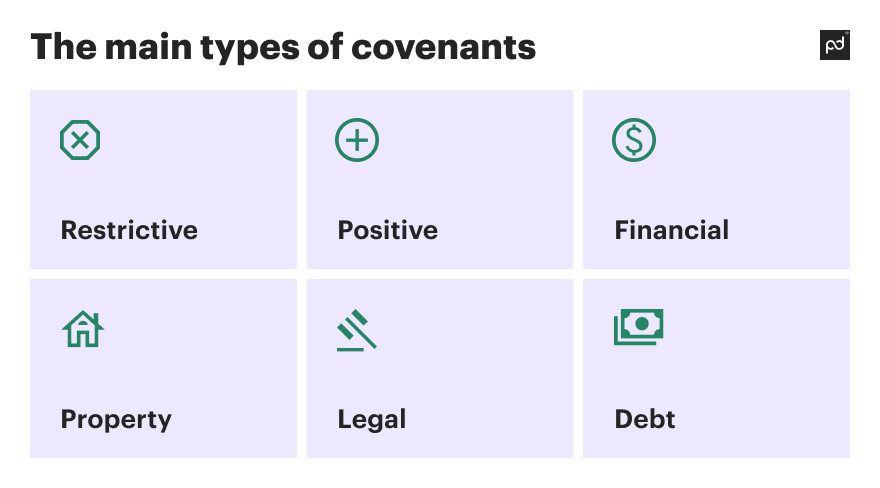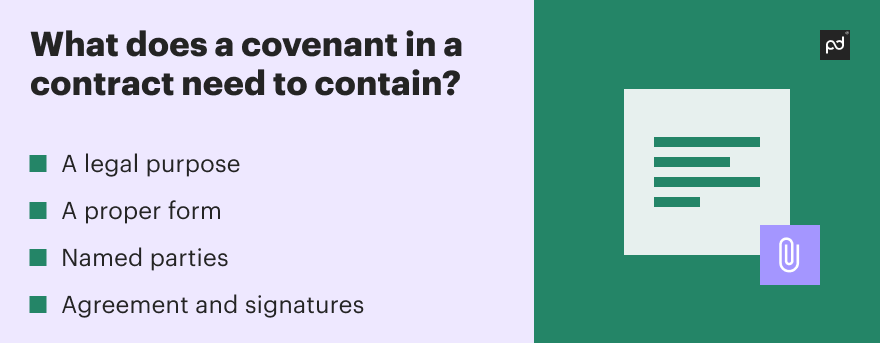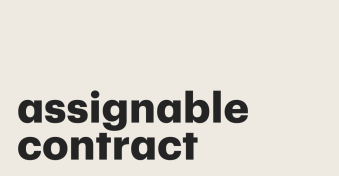It can often seem like legalese is from a different planet — yet understanding the terms used in legal documents is essential.
One such example is ‘covenants’ and, more specifically, how to write covenants in a contract. In this article, we look at what they are and the different scenarios where they can come in handy.
Key takeaways:
- Covenants may impose restrictions or insist on actions
- The intentions of a covenant should always be clear
- All signatories to a covenant must have the legal status to act as such
- Anyone entering into a covenant should have a clear understanding of their responsibilities
- If there are any consequences to breaking a covenant, then they must be clearly stated
What is a covenant in a contract?
So, let’s get to it — what are covenants in a contract, exactly?
Simply put, a covenant within a contract is an agreement that certain activities or things will or won’t happen once the contract is signed.
You’ll often find covenants in financial or property-related contracts, where one party wants a certain guarantee that something will or won’t occur.
For example, if someone were selling an old house that had a 300-year-old oak tree on the grounds, the seller may decide to include a covenant that forbids the new owner from removing it.
When a covenant focuses on making something happen, it’s a ‘positive covenant.’
When it stops something from occurring, as in the example above, it’s called a ‘negative’ or ‘restrictive covenant.’
The main types of covenants

Restrictive
If you include a restrictive covenant in a contract, then you’re looking to restrict the other party from performing certain actions.
This mechanism is commonly used in employment contracts, where the employer wants to ensure the employee doesn’t do anything that may be ‘damaging’ to their reputation.
There are three main types of restrictive covenant.
A non-solicitation agreement
Here’s a good example of how this restrictive covenant could be used.
A law firm doesn’t want their employee to take any clients (or staff) with them if they leave.
So, they have the employee sign a non-solicitation agreement that covers a certain period of time after they exit the company.
NDAs (non-disclosure agreements)
Say you were working for a tech firm.
You might be privy to certain developments or have information about the business’s intellectual property that would be damaging to the company (and advantageous to competitors) if it were ‘leaked.’
An NDA acts as a legally binding promise that you won’t share any of this confidential info.
NCAs (non-compete agreements)
Business can be fiercely competitive at times.
Including an NCA in a contract can prevent a talented employee from working for a competitor or setting up a business that offers the same services.
NCAs will often include geographical limitations and/or time restrictions.
Positive
A positive covenant (also known as an ‘affirmative covenant’) is a clause that requires the other party to carry out certain actions.
You’ll often find them in financial agreements, such as a loan contract.
In a loan contract, a covenant may include several conditions that accompany the loan itself.
For example, the lender may want to be sure the debtor has adequate insurance should they be made unemployed or suffer an injury that affects their ability to work.
When a positive covenant is broken, it can lead to a default scenario (though many lenders will allow the debtor some time to rectify any violation).
Financial
You may also hear financial covenants called ‘debt’ or ‘banking covenants.’
With this type of covenant, a clause is placed in the contract that limits or restricts the actions that can be undertaken by the borrower.
This can protect the lender from increased risk and instill financial discipline in the borrower.
Once a contract is signed, whether in person or using electronic signature software, any financial covenant is legally binding.
The conditions in it may vary but can include things like maintaining a certain debt-to-equity ratio.
Property
While you may think that buying a property (or piece of land) means you can do anything with it, a property covenant can restrict your actions — or, indeed, insist on certain actions being taken.
Either way, it represents a set of rules for what you can or cannot do as the owner.
A good example would be a house of historical interest.
A property covenant may be placed on the property to restrict certain actions, such as altering particular architectural features.
Property covenants can also cover maintaining a shared driveway or erecting a boundary wall or fence.
Legal
When the conditions contained in a covenant are not forbidden by law, then it’s a legal covenant, and those conditions are legally binding on all concerned parties.
If a party insists on a covenant, they must be sure the conditions they want to impose don’t breach federal or state law.
Ensuring a covenant is fully legal is essential.
A covenant can also include ‘knock-on’ effects.
For example, a property covenant may include a condition that a certain piece of land is to be develope — but if that land is home to a protected species, any development may contravene the laws that protect it.
Debt
A ‘debt covenant’ is simply another name for a financial covenant. See the section above for details.
What does a covenant in a contract need to contain?
If you want to include any sort of covenant when drawing up legal documents, then there are certain ‘rules’ it must adhere to to be legally binding.

These include:
A legal purpose
The purpose of the covenant must be legal and not contravene any law (state or federal) or go against public policy in that area.
For example, if you wish to include an NCA in an employment contract, there must be certain limitations pertaining to the geographical area or period it covers.
If your NCA is unlimited in scope, it may be unlawful. So, it might be fair to require a partner in your firm not to set up a new business in your city (or district) for a certain amount of time after they leave; however, if there are no set parameters to your NCA, it will not be legally binding.
A proper form
While no specific words are required to give your covenant form, there are certain conditions it must meet.
The intentions — and requirements — being imposed by or on each of the parties involved in the contract must be crystal clear.
Therefore, you must ensure complete clarity to any conditions included in it.
If you haven’t written a covenant into a contract before, it can be beneficial to look online for examples of the type of covenant you want to use.
Again, don’t worry about using specific legalese words or terms — the important thing is that the conditions being imposed are clearly understandable and legal.
Named parties
As with other types of legal contracts, you must be sure all parties concerned are legally able to enter into the covenant and contract.
There may be age restrictions, which can vary from state to state — generally, anyone viewed as a child can’t enter into a covenant.
There might also be a question of mental capacity.
If one of the parties is recognized as mentally incapacitated, they cannot enter into it either.
Put simply, each party must have the legal right and status to enter into the contract and fully understand it.
Agreement and signatures
There has to be consent and agreement too.
Each of the parties must consent to any conditions imposed by the covenant.
This extends to all conditions included in the contract as a whole.
If either party disagrees with even one of these, the covenant isn’t binding.
Of course, this assent is assumed to be given once the contract is signed.
This may take place in person or via electronic signing. It’s worth noting that certain forms of e-signature are valid in all 50 states.
Ensure you’re meeting all of the legal requirements before relying on these.
Easily write covenants in a contract with PandaDoc
It can often seem as though there’s endless paperwork involved in your job. However, by using document templates from PandaDoc, you can simplify this entire process.
The range of documents available, when you sign up for our tool, covers almost every eventuality and can guide you through the drawing up of any contract.
This will save your staff an enormous amount of time as they never need to draft them from scratch.
PandaDoc templates can not only help boost your business’s productivity but also reduce the likelihood of human error.
All you need to do is add any required details to the document and ensure there are no applicable local laws that need to be included.
Why not sign up for a free trial today?
Disclaimer
PandaDoc is not a law firm, or a substitute for an attorney or law firm. This page is not intended to and does not provide legal advice. Should you have legal questions on the validity of e-signatures or digital signatures and the enforceability thereof, please consult with an attorney or law firm. Use of PandaDoc services are governed by our Terms of Use and Privacy Policy.


